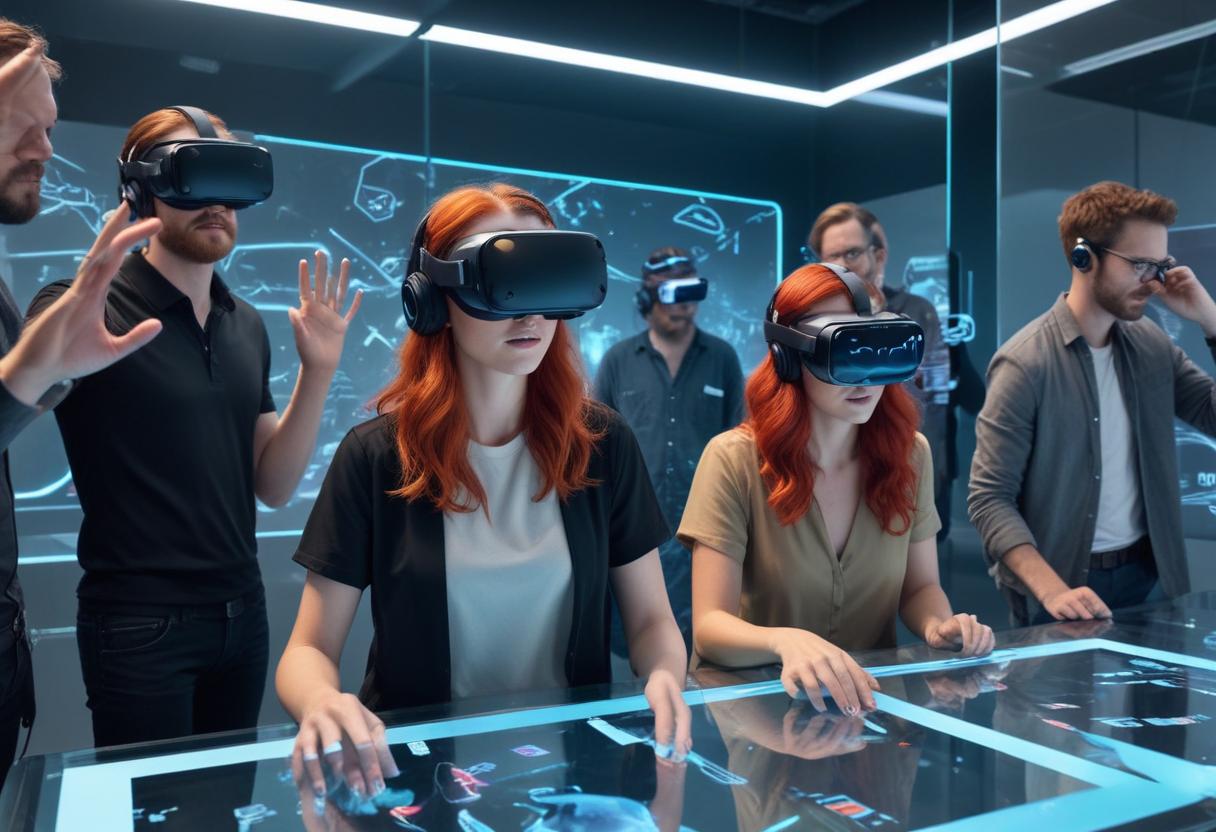Virtual Reality is no longer only found in fiction. Through Future-Proof VR Headsets, we can now interact with digital worlds in vivid new ways. From education to exploration, these virtual universes transport us as never before. Yet, as innovations accelerate, some devices may soon seem outdated. To stay on the cutting edge, we need options capable of evolving with technology. Here we uncover ten VR systems designed for the future, leading immersion into bold new realms.
1. Oculus Quest 2
The Oculus Quest 2 stands out as both remarkably advanced yet effortlessly approachable. Wireless and standalone, no PC is needed for its Qualcomm processor and 6GB RAM to amaze. High-resolution and speedy refresh showcase applications smoothly. Extensive libraries immerse through gameplay, also allowing optional tethering for amplified experiences.
2. HTC Vive Pro 2
For extraordinary fidelity, the HTC Vive Pro 2 caters to pros and fans alike. Its breathtaking 5K resolution ensures vision that dazzles. Fluid 120Hz motion engages through wide fields of view, while customizable fit and lenses please every user.
3. PlayStation VR 2
Sony’s groundbreaking PlayStation VR 2 promises to synergize seamlessly with the PS5, transporting players to vivid new realms. Cutting-edge 4K HDR visuals and integration aim to elevate immersion to whole new heights. Eye-tracking technology enables intuitive navigation while enhanced haptics and adaptive triggers heighten immersion. An expansive library boasts exclusive adventures.
4. Valve Index
The Valve Index is renowned for peerless craftsmanship and vivid presence. Gamers pursuing elevated performance and lifelike interactions favor it. Features include dual 1440 x 1600 displays at up to 144Hz, dexterous controllers with finger sensing, and customizable comfort with adjustable straps.
5. HP Reverb G2
Developed alongside Valve and Microsoft, the HP Reverb G2 excels with its crisp dual 2160 x 2160 panels and ergonomic design suitable for both play and productivity. Spatial audio immerses through built-in speakers while customizable lenses optimize vision.
6. Pimax Vision 8K X
For those demanding utmost sharpness, the Pimax Vision 8K X offers unrivaled visual fidelity. Intended for aficionados and professionals necessitating maximum clarity, it houses dual 3840 x 2160 screens spanning an immense 200-degree field of view within its modular form supporting add-ons.
7. Oculus Rift S
The Oculus Rift S provides a tethered experience with enhanced optics and inside-out tracking needing no external sensors, upgrading the original Rift. Balancing performance and ease, features include dual 1280 x 1440 displays at 80Hz.
8. Samsung Odyssey+ (Windows Mixed Reality)
The Windows Mixed Reality Samsung Odyssey+ couples vivid visuals with an adaptive structure. Ideal for versatile VR use, it employs dual 1440 x 1600 screens and technologies like Anti-Screen Door Effect. Built-in spatial AKG headphones enhance the immersive experience.
9. Varjo VR-3
Varjo’s polished VR-3 headset leads the frontier of high-fidelity virtual reality, offering unmatched visual acuity that enables immersive simulation across industries. Its 2880 x 2720 resolution per eye paired with a refined 90Hz refresh rate generates landscapes of unparalleled clarity and fluidity. Dual 12-megapixel cameras seamlessly blend physical and virtual environments, while sophisticated eye and hand tracking birth natural interactions that lessen simulator sickness.
10. Pico Neo 3
Pico’s budget-friendly Neo 3 proves that standalone virtual worlds need not be the domain of deep pockets alone. Donning wireless freedom courtesy of a Qualcomm Snapdragon brain, travelers may roam virtual groves unfettered by cables through its 1832 x 1920 displays running at a smooth 90Hz. Whether exploring imaginary lands or training for real-world tasks, the Neo 3 delivers engrossing experiences for all.
The Future of VR Headsets
Keen visions of the future see VR shedding its fetters. As optics evolve towards ever-higher pixel counts and smoother motions, immersion will intensify. Hands will gesture freely, unhindered by physical controllers. Eyes will roam naturalistically, communicating intent. Wireless independence will spread the magic of virtual reality to more. Augmenting rather than replacing reality, next-generation headsets may seamlessly blend digital additions with the physical world around us, unlocking novel ways of interacting with both.
Customization and Modularity
VR headsets are increasingly allowing customization and modularity, enabling users to configure devices to specific needs. This emerging trend may lead to more personalized and adaptable VR experiences catered for a wider range of individuals and industries.
A Promising Future
The potential for VR is tremendously promising, with technology advancing at a startling pace. Headsets like those above exemplify cutting-edge immersion, each offering unique attributes tailored to different demands and preferences. Whether an avid gamer, dedicated professional, or casual tech enthusiast, there exists a future-proofed VR headset perfectly suited. As innovations continue evolving, VR will undoubtedly transform how we interact with digital content, providing involvement more immersive, realistic, and engaging than ever before imagined. Dive into the world of VR and explore the limitless possibilities that lie ahead.
Highlighting Exciting Developments
By emphasizing distinctive features and conceivable future directions, this article aims to engage readers and underscore stimulating VR technological progressions. Please contact me should additional details on individual headsets or supplementary material be required!
The Role of VR in Various Industries
Virtual Reality is not just limited to gaming and entertainment. Its applications are broad and transformative across numerous industries:
Education and Training
In the realm of education, VR provides immersive learning experiences that textbooks simply can’t match. Students can explore historical sites, conduct virtual science experiments, and interact with complex 3D models, making learning both engaging and effective. Training simulations for fields like medicine, aviation, and the military offer safe environments for students and professionals to hone their skills without real-world risks.
Healthcare
The healthcare industry is leveraging VR for both treatment and training. Surgeons can practice procedures in a virtual environment, improving their skills before operating on actual patients. VR therapy is also used for pain management, physical therapy, and treating mental health conditions such as PTSD and anxiety, providing patients with innovative treatment options.
Real Estate and Architecture
In real estate and architecture, VR allows potential buyers to tour properties remotely, saving time and resources. Architects can present their designs in a virtual space, enabling clients to walk through and interact with their future homes or office buildings before construction begins. This technology ensures better planning and decision-making.
Enhancing Social Interactions
Virtual Reality is revolutionizing the way we connect and communicate. Social VR platforms like VRChat and AltspaceVR offer users the opportunity to interact in virtual environments, attend events, and create communities. These platforms break down geographical barriers, allowing people from around the world to meet and share experiences as if they were in the same room.
The Future of VR in Entertainment
The entertainment industry continues to push the boundaries of what is possible with VR:
Gaming
Gaming remains one of the most significant drivers of VR innovation. Developers are creating more immersive and interactive games that take full advantage of VR capabilities. Future games will likely feature more sophisticated AI, expansive open worlds, and even more seamless integration with physical actions, creating truly lifelike experiences.
Movies and Television
VR filmmaking is an emerging art form, offering viewers a 360-degree perspective that traditional media cannot match. Directors are experimenting with new ways to tell stories, immersing audiences directly into the narrative. This technology could transform how we consume movies and TV shows, making them more interactive and engaging.
Overcoming Challenges in VR
Despite its promising future, VR technology still faces several challenges that need to be addressed:
Accessibility
Making VR more accessible to a broader audience is crucial. This includes reducing the cost of high-quality headsets and ensuring they are user-friendly. Companies are working on developing more affordable options without compromising on performance.
Physical Discomfort
Motion sickness and discomfort are common issues for some VR users. Innovations in frame rates, display quality, and ergonomic design are helping to mitigate these problems. Future advancements may entirely eliminate these issues, making VR comfortable for everyone.
Content Development
The creation of high-quality, engaging VR content requires significant time and resources. Encouraging more developers to enter the field and providing tools for easier content creation will be essential for the continued growth of VR.
Conclusion
The potential for Virtual Reality is boundless. With advancements in technology, VR headsets are becoming more sophisticated, offering users unprecedented levels of immersion and interaction. From education and healthcare to gaming and social interactions, VR is transforming how we experience the world.



